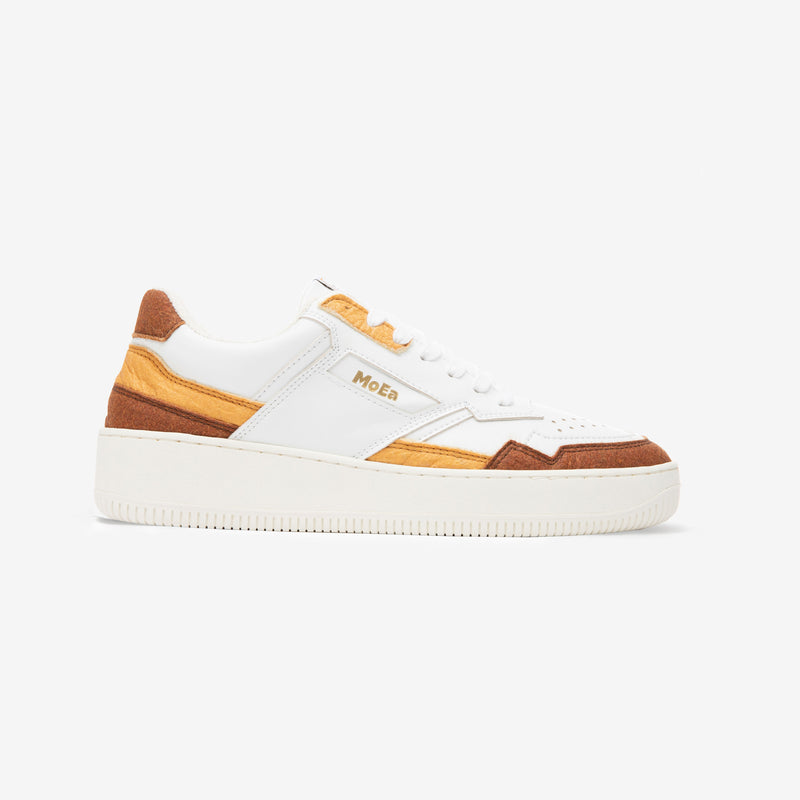Animal leather’s days are numbered. At the same time as consumers around the globe are waking up to the harsh realities of the leather industry, a few innovative companies are developing plant-based alternatives that mimic the properties of animal leather without the multitude of environmental, social, and ethical problems. Of course, just because these alternatives exist doesn’t mean consumers will automatically jump ship and swim to the life rafts of compressed cactus protein and felted pineapple leaves. First, questions must be answered—namely, how the heck is this stuff made?? Well fear not dear reader! That’s exactly what we’re going to learn about today. At the moment, three raw materials lead the plant leather pack: cactus, pineapple, and mushroom. I don’t own any products made from these plant leathers (yet), but I’m excited to try them soon and report back. Now let’s get into the production, the pros, and the cons of these exciting new materials!
Cactus Leather
A common sight in Mexican cuisine and Mexican deserts alike, the nopal cactus is the main ingredient in Desserto, the plant-based leather developed by Mexican company Adriano Di Marti. This innovative material has caused quite a stir in the fashion industry’s more eco-minded circles thanks to its breathability, durability, and aesthetic resemblance to animal leather.
The production of Desserto leather begins at an organic cactus plantation in north-central Mexico where mature leaves are harvested every 6–8 months. Nopal cactus can live for up to 8 years, so leaving the younger leaves untouched ensures the cacti can continue to grow. The collected cactus leaves are washed, mashed, and left out to dry in a solarium for three days—a step that requires no energy input aside from good ol’ sunlight! Once this cactus pudding is dry it is ground into a powder, mixed with non-toxic chemicals (which Desserto has not disclosed), then pressed and coated to create the final leather-like product.
From a production sustainability standpoint, Desserto leather might be the most impressive of the plant leather bunch. The incredible hardiness of nopal means it can be grown with no irrigation, no herbicides, and no pesticides, while its perennial life cycle allows the same plant to be harvested multiple times. The main downside of Desserto cactus leather is that it’s not biodegradable—plastics like polyurethane still make up a substantial portion of the finished product. These plastics are integral to Desserto leather’s durability and texture, but unfortunately complicate its claim as a truly green leather alternative.
Pineapple Leather
A veritable veteran in the young field of veggie leather, Piñatex is a pineapple-based textile developed by British company Ananas Anam. The manufacturing process begins in the Philippines, where waste pineapple leaves are gathered after pineapple harvest. The leaves are mechanically broken down into their composite fibres and left out to dry in the sun. The dried leaf fibres are then cleaned to remove impurities, and the resulting fluff is mixed with corn-based polylactic acid and pressed into Piñafelt, the foundational material from which all Piñatex products are made. Rolls of Piñafelt are shipped from the Philippines to finishing factories in Spain or Italy, where they can be coated with resin, colored with GOTS certified pigments, pressed with foil for a metallic finish, or bonded with solid polyurethane to create a waterproof material.
Much like Desserto, Piñatex’s strengths lie in the production stage: the raw material is an agricultural waste product and unusable pineapple fibres can be recycled as fertilizer. Alas, Piñatex also shares Desserto’s weakness of not being completely biodegradable. Piñafelt is biodegradable in theory, but only under specific industrial composting conditions. In a landfill, its polylactic acid component behaves no differently than petroleum-based plastics, taking hundreds or thousands of years to fully decompose. Additionally, finished Piñatex leathers all contain polyurethane to enhance their durability and water resistance, meaning the commercial product isn’t biodegradable and contains a significant amount of petroleum-based plastic.
Mushroom Leather
Mycelium, the complex root-like structure of fungus, is the source material for two competing mushroom leather companies: Mylo and MycoWorks. Despite similarities in materials and location (both are based in Emeryville, California), each company takes a unique approach to crafting its own proprietary material. Of the two, Mylo’s Unleather is the more commercially available, having already collaborated on limited runs of product with influential brands like Adidas and Lululemon. Mylo is tight-lipped about their manufacturing process, but what we do know is that their product is not yet biodegradable. Unfortunately, plastics are still an essential component of Mylo Unleather for achieving the durability and texture demanded by the leather market.
MycoWorks, on the other hand, are the visionary mad scientists of the vegetable leather industry. Their mycelium-based Reishi leather is plastic-free, completely biodegradable, and arguably the most promising of all the materials we’ve reviewed here. With their seemingly magical Fine Mycelium technology, MycoWorks can direct mycelium threads to grow in specific patterns that greatly increase the strength of the finished material. Different textures and properties can be achieved depending on how the mycelium is grown. This bioengineering wizardry also enables mycelium to be grown directly into the shape of a final product, which could drastically reduce waste in the manufacturing process—think of it like 3D printing with mushroom roots. Once the mycelium is grown and pressed, it’s shipped off to a renowned Spanish tannery which vegetable tans the leather and gives it a luxurious finish that is strikingly reminiscent of high-end animal leather. If this all sounds expensive, that’s because it is. Reishi is currently the least accessible material of those mentioned here, both in terms of price and availability. Case in point: the first object made with Fine Mycelium technology was an Hermès bag in 2021. Thankfully, MycoWorks has secured a boatload of financial backing and are drastically scaling up their production, which will in turn mean more accessible price points for the consumer. If all goes according to MycoWorks’ plan, the 2020s will be the decade of mushroom leather and we can leave all those poor cows alone.
Get more like this—Sign up for our daily inspirational newsletter for exclusive content!
__
Photo: Matteo Minoglio via Unsplash






